Special Air Service Regiment
This includes providing unique capabilities to support sensitive strategic operations, hostage rescue,[8] advisory and training assistance, special reconnaissance, precision strike and direct action".[38][39][40][41] Operating in small groups of four to six men they moved more slowly than conventional infantry through jungle or bushland and were heavily armed, employing a high rate of fire to simulate a larger force on contact and to support their withdrawal.[42] On occasion, SASR patrols were also deployed by M-113 armored personnel carriers (APCs) with a method devised to deceive the Viet Cong as to their insertion and the location of their drop-off point despite the noise they made moving through the jungle.[47] During its time in Vietnam the SASR proved highly successful, with members of the regiment known to the Viet Cong as Ma Rung or "phantoms of the jungle" due to their stealth.[54] In July 1977 two SASR patrols were deployed to north Irian Jaya with the approval of Indonesian authorities to provide first aid to the survivors of an RAAF Iroquois helicopter which had crashed in the remote jungle during survey operations, and to secure the wreckage from possibly being captured by members of the OPM independence movement.On one such exercise in the Philippines, a US special forces C-130 Hercules crashed into the South China Sea shortly after take-off from Subic Bay on 26 February 1981, killing 23 passengers including three Australians from the SASR, as well as a number of Americans, Filipinos, and New Zealanders.[64] The regiment was not involved in operations during the Gulf War in 1991 although two troops were again placed on standby for deployment at short notice,[65] while other elements remained on high alert to respond to a terrorist incident in Australia if required.Small numbers of SASR personnel were involved in Operation Habitat in Turkey and Northern Iraq as medics to assist Kurdish refugees between May and June 1991.They were subsequently involved in a number of actions, including an incident on 21 May when they were flown to the scene of a downed Canadian civilian helicopter 20 kilometres (12 mi) north of Mogadishu to protect the crew.[71] In August 1994 SASR-qualified medical personnel were deployed as part of the contribution to the United Nations Assistance Mission for Rwanda, some of whom were present during the Kibeho Massacre in April 1995, for which one SASR soldier and two other Australians were awarded the Medal for Gallantry for their actions.[72] In addition, individual members of the SASR have been attached to a wide range of Australian peacekeeping deployments as observers, including in Kashmir, Lebanon and in the Sinai.Crash survivors, soldiers from the other helicopters and exercise staff risked the flames and exploding ammunition to rescue their comrades and retrieve the bodies of the dead.While the crisis was resolved peacefully, if military action had been taken the SASR would have been used in the combat search and rescue (CSAR) role to recover aircrew shot down by Iraqi air defences.[110][111][Note 3] In October 2001, the Australian government announced that it was sending a special forces task group built around an SASR squadron to participate in the campaign against al-Qaeda and the Taliban in Afghanistan designated Operation Slipper.[114] After arriving at FOB Rhino, the SASR initially operated in southern Afghanistan with US Marines from Task Force 58, conducting long-range vehicle mounted patrols over several hundred kilometres around Kandahar and into the Helmand Valley near the Iranian-border.[115] On 16 February 2002 Sergeant Andrew Russell was killed when the Long Range Patrol Vehicle (LRPV) he was travelling in hit a land mine during an operation in the Helmand Valley.[134][135] In addition to the SASR's contribution to the SOTG, the regiment also provided "Defence Support Teams" to protect Australian Secret Intelligence Service (ASIS) agents in Afghanistan.[137] On 26 March 2013, it was announced that Special Operations Command would receive the Australian Army's first battle honour since the end of the Vietnam War for outstanding performance during the Shah Wali Kot Offensive in Afghanistan from May to June 2010.[155] The SASR provided the majority of the ground-force element of the Australian contribution to the 2003 U.S.-led invasion of Iraq, known as Operation Falconer, moving in quickly and successfully, thus enhancing Australia's standing amongst its allies.[157][158] B and C Troops of the SAS Squadron crossed the Iraqi border from Jordan on the night of 19 March by vehicle, penetrating 30 kilometres (19 mi) before engaging in one of the first actions of the war.[165][166] An SASR team was deployed to Iraq in May and June 2005 as part the effort to free Douglas Wood, an Australian engineer kidnapped in Baghdad; however, he was later recovered alive by US and Iraqi forces.[178] On 29 November 2006, a Black Hawk helicopter from the 171st Aviation Squadron carrying four crew and six soldiers from the SASR crashed while attempting to land on HMAS Kanimbla and sank in international waters off Fiji.[185] However, it has been reported that the SASR has conducted intelligence gathering expeditions overseas since the late 1980s, during which a select few personnel have travelled for months at a time, with the first in Asia being to Laos, Cambodia and Burma.[12] Qualified SASR members wear a sandy-coloured beret with a metal, gold and silver badge, depicting the sword Excalibur, with flames issuing upwards from below the hilt, with a scroll across the front of blade inscribed with the regimental motto "Who Dares Wins", on a black shield.[23] SAS 'Ibis'-style parachute wings (rounded at the bottom and straight on top) are worn on the right shoulder on general duty, ceremonial and mess dress uniforms only.[218][221] Flash bang devices and fragmentation grenades are also used depending on the tactical situation, including the thermobaric Mk 14 Anti-Structure Munition (ASM-HG) which has reportedly been used in Afghanistan.[225][226][227][228] New SOV-Logistics trucks are being acquired to replace the Mercedes-Benz Unimog for supply, support and recovery of the SOV-SR.[229] A lighter, less protected vehicle, more akin to the LRPV—the Polaris Defense DAGOR (Deployable Advanced Ground Off-road)—was being trialled in 2015.[239] Successful candidates then continue on to the 21-day SAS Selection Course which assesses both the individual's strength and endurance (mental and physical), as well as overall fitness, ability to remain calm in combat, and to work effectively in small teams.Additional facilities include a special urban complex, vertical plunging range, method of entry house, and simulated oil rig and aircraft mock-ups in order to provide realistic training environments for potential operational scenarios.[253] Despite a possible reduction in rank, SASR operators receive significant allowances, which make them among the highest-paid soldiers in the Australian Defence Force, with a trooper (equivalent to a private) reportedly earning about $100,000 per annum in 2006.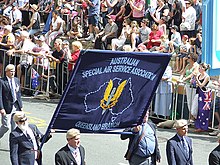

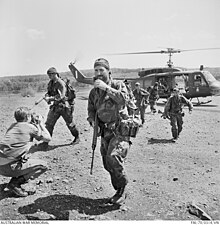
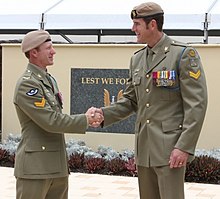
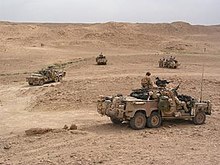
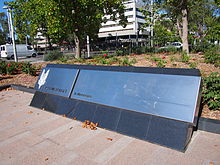
Special Air ServiceNew Zealand Special Air ServiceSAS Australia (disambiguation)AustraliaAustralian ArmySpecial forcesSpecial mission unitSpecial operationsCounter-terrorismregimentSpecial Forces GroupCampbell BarracksSwanbourne, Western AustraliaWho Dares WinsThe Happy WandererLili MarleneIndonesian ConfrontationVietnam WarSomali Civil War1999 East Timorese crisisINTERFETWar on TerrorAfghanistan WarOperation SlipperIraq WarOperation FalconerMilitary intervention against ISILOperation Okra2006 East Timorese crisisOperation AstuteUnit Citation for GallantryMeritorious Unit CitationPresidential Unit CitationMichael JefferyJim WallaceDuncan LewisMike HindmarshTim McOwanGus GilmoreRick BurrcompanyBritish SASSwanbourneSpecial Operations CommandBorneoreconnaissanceVietnamUS Army Special ForcesViet CongSydney Hilton bombingSomaliaEast TimorAfghanistancounter-terroristwar crimeshostage rescuespecial reconnaissancedirect actionlong range reconnaissancecounter-insurgencypatrolsintelligenceair strikesparachutehigh altitude parachutesubmarineTactical Assault Group (West)Police Tactical Groups2nd Commando RegimentZ Special UnitM Special UnitIndependent CompaniesCoastwatchersSouth West Pacific AreaWorld War IIdemobilisation of the Australian militaryMalayan EmergencyPerth, Western AustraliaRoyal Australian Regimentcommandopentropic organisationsabre squadronsMilitary history of Australia during the Indonesia–Malaysia confrontationNorth BorneoIndonesia–Malaysia confrontationtroopersNew ZealandMalaysiaOperation ClaretMilitary history of Australia during the Vietnam WarOperation CoburgNui Dat1st Australian Task ForcePhuoc Tuy ProvinceBien HoaLong KhanhBinh TuyNo. 9 Squadron RAAFarmored personnel carriersMACV-SOGdefence of continental AustraliaNorthern AustraliaRegional Force Surveillance UnitsIrian JayaOPM independence movementC-130 HerculesSubic BayClearance Diving BranchOperation Morris DanceGulf WarpeacekeepingOperation HabitatWestern SaharaForce Communications UnitSpecial Boat ServiceMogadishuUnited Nations Assistance Mission for RwandaKibeho MassacreMedal for GallantryS-70-A9 Black Hawkhelicopters5th Aviation RegimentFire Support BaseTownsvillenight vision goggleslanding zone